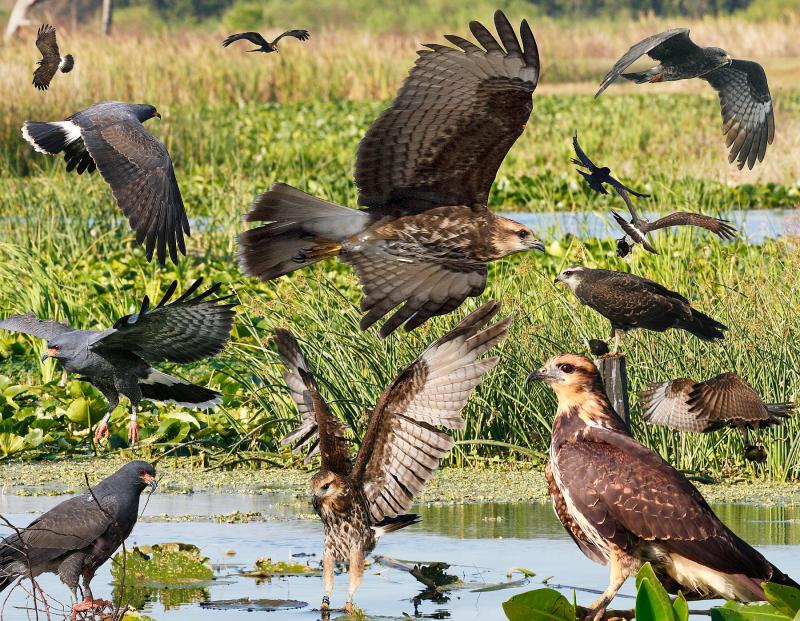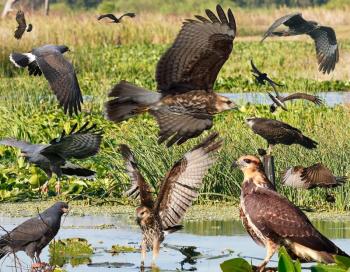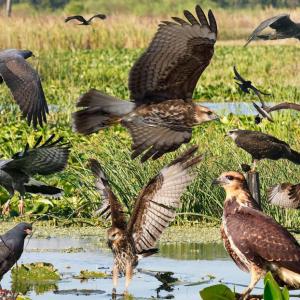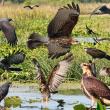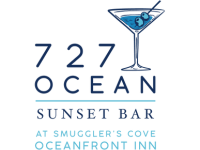Searching for a Snail Kite in Wild America
For some reason neither of us can remember, we decided recently to reread a classic book about birding and natural history called “Wild America.” The book, written in a unique interweaving set of first-person entries by Roger Tory Peterson and James Fisher, recounts a 100-day trip of 30,000 miles that the two made across Canada and the U.S. in 1953. The two set a new record for the number of species seen in one year in North America, but more importantly, brought to life the adventure of seeing a continent’s most incredible natural areas, shared with vivid descriptions of birds, animals, and plants, and the landscapes they inhabited.
Roger Tory Peterson was one of the most well-known naturalists of his time, having written and illustrated the first major field guide for North American birds. He went on to publish such books for a number of different regions and for other animals and plants. James Fisher was one of the most famous British ornithologists. Both were leaders in making birding a popular pursuit in their respective countries, and both had written many books and were involved in radio shows and natural history films even before they embarked on the journey that they recounted in “Wild America.”
Today, the 500-plus species that they identified on the trip—a world record at the time—has been eclipsed by multiple Big Year records of 700+ species. But reading their stories of that magical 100 days still can make you nostalgic to see the special places they visited.
We happened to be reading the part of the book about the time that Peterson and Fisher spent in Florida just before and during our own trip to Florida, from where we are writing this week’s column. Back in the 1950s when they visited, Florida had not yet experienced the massive boom in population that has erased and fractured so much of the natural landscape of this unique state. Still, some birds that they searched for were less common at that time then they are now.
In the book, the two birders describe their search for what they called the Everglades kite in Lake Okeechobee in south central Florida. At that time, these were considered one of the rarest birds in the U.S., with only a few dozen thought to be remaining. The Florida birds are really the northernmost and only U.S. population of what is called today the snail kite, a species found through part of the Caribbean and from Mexico south through much of South America.
The Florida population of snail kite, often now described as the Everglades snail kite, was declared Federally Endangered in 1967 and remains so today. Numbers reached the thousands in the 1990s but declined to below 1,000 after about the year 2000. We have never seen an Everglades snail kite, so after reading about them again in “Wild America,” we checked eBird for a close place to where we were in Florida where any had been recently seen. Fitting our search into a longer family excursion involving a German bakery, we found our way to the Emeralda Marsh Conservation Area, a spot we had never visited before, south of Ocala. At least one snail kite had spent some time here in recent months, based on eBird data. We enjoyed seeing scads of ibises, herons, egrets, and others birds, many of them up close and personal as we drove through the marshy expanse. Alas, we did not find a snail kite. That species will remain on our wish list at least until next year.
We wonder what bird or place that “Wild America” will make us yearn for next!
Jeffrey V. Wells, Ph.D., is a Fellow of the Cornell Lab of Ornithology. Dr. Wells is one of the nation's leading bird experts and conservation biologists and author of the “Birder’s Conservation Handbook.” His grandfather, the late John Chase, was a columnist for the Boothbay Register for many years. Allison Childs Wells, formerly of the Cornell Lab of Ornithology, is a senior director at the Natural Resources Council of Maine, a nonprofit membership organization working statewide to protect the nature of Maine. Both are widely published natural history writers and are the authors of the book, “Maine’s Favorite Birds” (Tilbury House) and “Birds of Aruba, Bonaire, and Curaçao,” (Cornell University Press).
Event Date
Address
United States

